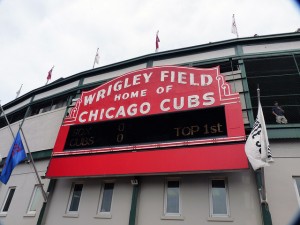 The Chicago Cubs sued several individuals last week, alleging that they dressed as “Billy Cub,” a bear wearing a Chicago Cubs’ uniform, while “lurking” outside of Wrigley Field, posing for photographs with the fans, engaging with them “and then seek[ing] to hustle those same fans for “fees” or tips.” Defendants were either working alone or “in combination of approximately four “Billy Cub” characters at the time.” They were carrying a cooler “with a handmade “pics for tips” sign taped to its side.”
The Chicago Cubs sued several individuals last week, alleging that they dressed as “Billy Cub,” a bear wearing a Chicago Cubs’ uniform, while “lurking” outside of Wrigley Field, posing for photographs with the fans, engaging with them “and then seek[ing] to hustle those same fans for “fees” or tips.” Defendants were either working alone or “in combination of approximately four “Billy Cub” characters at the time.” They were carrying a cooler “with a handmade “pics for tips” sign taped to its side.”
The practice of wearing costumes to solicit tips for photo-ops is familiar to anyone who recently passed by Times Square in New York, where individuals dressed as Spiderman or Elmo, while not affiliated with Marvel Comics or Sesame Street or its affiliates, line the sidewalks offering their services as a photograph prop. There are two legal issues in this type of behavior: concerns about safety, as such individuals may “hustle” tourists or fans, and intellectual property issues.
The security issue is real. The New York Times reported yesterday that an individual dressed as Spiderman was arrested this weekend in Times Square after having punched a police officer who had informed a tourist that she was not required to tip “Spiderman.” Indeed such costumed individuals are even being blamed by some for the decline in Broadway tickets sales. New York City Councilman Dan Garodnick (D-Manhattan) is reportedly drafting a bill which would require a license to be able engage in such activities in New York City.
The Cubs complaint alleges that [d]efendants’unsavory actions recently have escalated to physical violence,” giving as example an instance when one of the defendants, dressed as Billy Cub, allegedly started a fight at a bar in April 2014. The complaint also states that Defendants “have made rude, profane and derogatory remarks and gesticulations” when dressed as the Cubs mascot outside of Wrigley Field. The Chicago Cubs had sent defendants a cease-and-desist letter last year and engaged in negotiations with them “to avoid litigation” but it seems that they decided to sue after the alleged April bar brawl episode, fearing that such behavior would be associated with the team.
The other legal issue in an unauthorized use of a mascot is the possible copyright and trademark infringement, and that is the crux of the Cubs’complaint. The complaint claims trademark infringement, trademark dilution by tarnishment, trademark dilution by blurring, and unfair competition.
The costume worn by defendant is described in the complaint as a bear “wearing a Cubs cap and baseball jersey, each bearing the famous marks and trade dress of the Cubs.” “Billy Cub” is not the official mascot of the Chicago Cubs, it is instead Clark the Cub, a tall brown teddy bear wearing the team’s uniform. He (it?) poses in front of Wrigley Field with fans, but does not ask for tips
The complaint claims that the CUBS mark is a ‘famous’ trademark under 15 U.S.C. § 1125(c), the Federal Trademark Dilution Act of 1995, revised by the Trademark Dilution Revision Act of 2006, and that defendants’unauthorized use of the mark tarnished the Cub’s reputation and goodwill. The Trademark Act indeed provides remedies for owners of a famous mark if a third party made an unauthorized use of the mark which causes dilution by blurring or by tarnishment. It is not necessary that there is an actual consumer confusion, meaning that, in this case, the owners of the famous CUBS mark would not be required to prove that consumers actually believed that under the “Billy Cub’ outfit there was a Chicago Clubs employee. Likelihood of dilution is sufficient. The complaint nevertheless lists several examples of consumer confusion, as posted on Twitter, expressing beliefs that it had been Clark the Cub who (which?) had started a fight at a bar.
The Cubs are seeking an order that Defendant’s merchandise bearing the CUBS marks be destroyed, that Defendantsremove reference to the CUBS marks on their websites, and they are also seeking damages.
Image is Chicago 2011, courtesy of Flickr user karlnorling under a CC BY 2.0 license.



